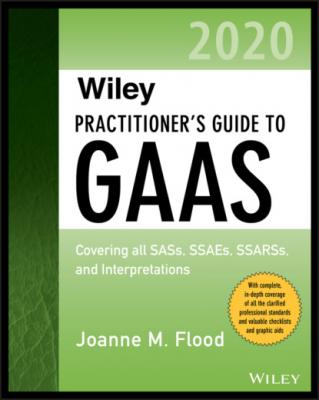Wiley Practitioner's Guide to GAAS 2020. Joanne M. Flood
Читать онлайн.| Название | Wiley Practitioner's Guide to GAAS 2020 |
|---|---|
| Автор произведения | Joanne M. Flood |
| Жанр | Бухучет, налогообложение, аудит |
| Серия | |
| Издательство | Бухучет, налогообложение, аудит |
| Год выпуска | 0 |
| isbn | 9781119596035 |
PUBLICATION CURRENCY
This publication is current through SAS No. 137, SSARS 24, and SSAE 18.
Joanne M. Flood
September 2020
ABOUT THE AUTHOR
Joanne M. Flood, CPA, is an author and independent consultant on accounting and auditing technical topics and e-learning. She has experience as an auditor in both an international firm and a local firm and worked as a senior manager in the AICPA’s Professional Development group. She received her MBA summa cum laude in accounting from Adelphi University and her bachelor’s degree in English from Molloy College. Joanne received the New York State Society of Certified Public Accountants Award of Honor for outstanding scholastic achievement at Adelphi University. Joanne also has a certificate in Designing Interactive Multimedia Instruction from Teachers College, Columbia University.
While in public accounting, Joanne worked on major clients in retail, manufacturing, and finance and on small business clients in construction, manufacturing, and professional services. At the AICPA, Joanne developed and wrote e-learning, text, and instructor-led training courses on US and international standards. She also produced training materials in a wide variety of media, including print, video, and audio, and pioneered the AICPA’s e-learning product line. Joanne resides on Long Island, New York, with her daughter, Elizabeth. Joanne is the author of the following Wiley publications:
Financial Disclosure Checklist
Wiley GAAP 2020: Interpretation and Application of Generally Accepted Accounting Principles
Wiley Practitioner’s Guide to GAAS 2020: Covering All SASs, SSAEs, SSARSs, and Interpretations
Wiley GAAP: Financial Statement Disclosures Manual (Wiley Regulatory Reporting), coming soon
Wiley Revenue Recognition
1 AU-C 200 Overall Objectives of the Independent Auditor and the Conduct of an Audit in Accordance with Generally Accepted Auditing Standards
Objectives of AU-C Section 200
Professional Judgment and Skepticism
SCOPE
AU-C 200 describes the auditor’s overall responsibilities when conducting a GAAS audit, including the auditor’s overall objectives and the nature and scope of the audit. Also included in AU-C 200 are the scope, authority, and structure of GAAS. (AU-C 200.01)
DEFINITIONS OF TERMS
Source: AU-C 200.14. For definitions related to this standard, see Appendix A, “Definitions of Terms”: Applicable financial reporting framework, Audit evidence, Audit risk, Auditor, Detection risk, Financial reporting framework, Financial statements, Historical financial information, Interpretive publications, Management, Misstatement, Other auditing publications, Premise, relating to the responsibilities of management and, when appropriate, those charged with governance, on which an audit is conducted (the premise), Professional judgment, Professional skepticism, Reasonable assurance, Risk of material misstatement, Those charged with governance.
OBJECTIVES OF AU-C SECTION 200
The overall objectives of the auditor, in conducting an audit of financial statements, are to
1 obtain reasonable assurance about whether the financial statements as a whole are free from material misstatement, whether due to fraud or error, thereby enabling the auditor to express an opinion on whether the financial statements are presented fairly, in all material respects, in accordance with an applicable financial reporting framework; and
2 report on the financial statements, and communicate as required by GAAS, in accordance with the auditor’s findings.
(AU-C 200.12)
If reasonable assurance cannot be obtained and a qualified opinion is insufficient, the auditor must either disclaim an opinion or withdraw from the engagement when possible under applicable law or regulation. (AU-C 200.13)
REQUIREMENTS
Management’s Responsibilities
Financial statements are prepared by management with oversight from those charged with governance. GAAS do not impose requirements on management or those charged with governance, but rather an audit is conducted on the premise that management and those charged with governance understand their responsibilities. (AU-C 200.05)
Many times clients do not understand their responsibilities for audited financial statements. The financial statements are management’s. They contain management’s representations. The form and content of the financial statements are management’s responsibility, even if the auditor prepared them or participated in their preparation.
Management also is responsible for implementing and maintaining an effective system of internal control.
Auditor’s Objectives
The purpose of an audit of financial statements is confined to the expression of an opinion on the financial statements being audited. In performing the audit, the auditor is responsible for compliance with GAAS. (AU-C 200.04)
In every audit, the auditor has to obtain reasonable assurance1 about whether the financial statements are free of material misstatement, whether due to errors or to fraud. (AU-C 200.06) Materiality is taken into account when planning and performing the audit. Misstatements are considered material, individually or in the aggregate, when they could reasonably be expected to influence economic decisions made by financial statement users. However, the auditor is not required to obtain reasonable assurance that misstatements not material to the financial statements taken as a whole, whether caused by fraud or error, are detected. Materiality considers qualitative and quantitative elements and should be viewed in context. (AU-C 200.07)
The auditor has a responsibility to consider GAAS in all audits. For more information, see the section “Complying with GAAS” later
